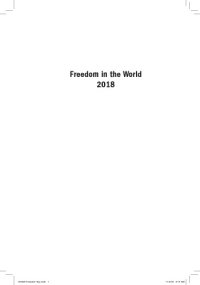
Ebook: Freedom in the World 2018: The Annual Survey of Political Rights & Civil Liberties
Author: Arch Puddington, Jennifer Dunham
- Year: 2019
- Publisher: Freedom House
- Language: English
- pdf
The Freedom in the World 2018 survey contains reports on 195 countries and 14 terri- tories. Each country report begins with a section containing the following information: pop- ulation, capital, political rights rating (numerical rating), civil liberties rating (numerical rating), freedom rating (the average of the political rights and civil liberties ratings), free- dom status (Free, Partly Free, or Not Free), and “electoral democracy” designation. Each territory report begins with a section containing the same information, except for the capital and the electoral democracy designation. The population figures are drawn primarily from the 2016 World Population Data Sheet of the Population Reference Bureau.
The political rights and civil liberties ratings range from 1 to 7, with 1 representing the most free and 7 the least free. The status designation of Free, Partly Free, or Not Free, which is determined by the average of the political rights and civil liberties ratings, indicates the general state of freedom in a country or territory. Any improvements or declines in the rat- ings since the previous survey are noted next to the relevant number in each report. Positive or negative trends that were not sufficient to trigger a ratings change may be highlighted by upward or downward trend arrows, which are located next to the name of the country or territory. A brief explanation of ratings changes or trend arrows is provided for each country or territory as required. For a full description of the methods used to determine the survey’s ratings, please see the chapter on the survey’s methodology.
Following the section described above, each country and territory report is composed of three parts: an overview, bullets on key developments, and an analysis of political rights and civil liberties. The overview provides a succinct, general description that explains the country or territory’s place on the 0–7 rating scale; bullets on key developments summarize key events that took place in 2017; and the section on political rights and civil liberties an- alyzes the degree of respect for the rights and liberties that Freedom House uses to evaluate freedom in the world. This section is composed of seven parts that correspond to the seven main subcategories in the methodology and justify a country or territory’s score for each indicator. The scores for each indicator, subcategory, and category, along with any changes from the previous year, are noted next to the relevant subheading. Some reports have an ex- ecutive summary that analyzes the year’s major developments and why they are significant for the country or territory’s state of freedom.
The political rights and civil liberties ratings range from 1 to 7, with 1 representing the most free and 7 the least free. The status designation of Free, Partly Free, or Not Free, which is determined by the average of the political rights and civil liberties ratings, indicates the general state of freedom in a country or territory. Any improvements or declines in the rat- ings since the previous survey are noted next to the relevant number in each report. Positive or negative trends that were not sufficient to trigger a ratings change may be highlighted by upward or downward trend arrows, which are located next to the name of the country or territory. A brief explanation of ratings changes or trend arrows is provided for each country or territory as required. For a full description of the methods used to determine the survey’s ratings, please see the chapter on the survey’s methodology.
Following the section described above, each country and territory report is composed of three parts: an overview, bullets on key developments, and an analysis of political rights and civil liberties. The overview provides a succinct, general description that explains the country or territory’s place on the 0–7 rating scale; bullets on key developments summarize key events that took place in 2017; and the section on political rights and civil liberties an- alyzes the degree of respect for the rights and liberties that Freedom House uses to evaluate freedom in the world. This section is composed of seven parts that correspond to the seven main subcategories in the methodology and justify a country or territory’s score for each indicator. The scores for each indicator, subcategory, and category, along with any changes from the previous year, are noted next to the relevant subheading. Some reports have an ex- ecutive summary that analyzes the year’s major developments and why they are significant for the country or territory’s state of freedom.
Download the book Freedom in the World 2018: The Annual Survey of Political Rights & Civil Liberties for free or read online
Continue reading on any device:

Last viewed books
Related books
{related-news}
Comments (0)